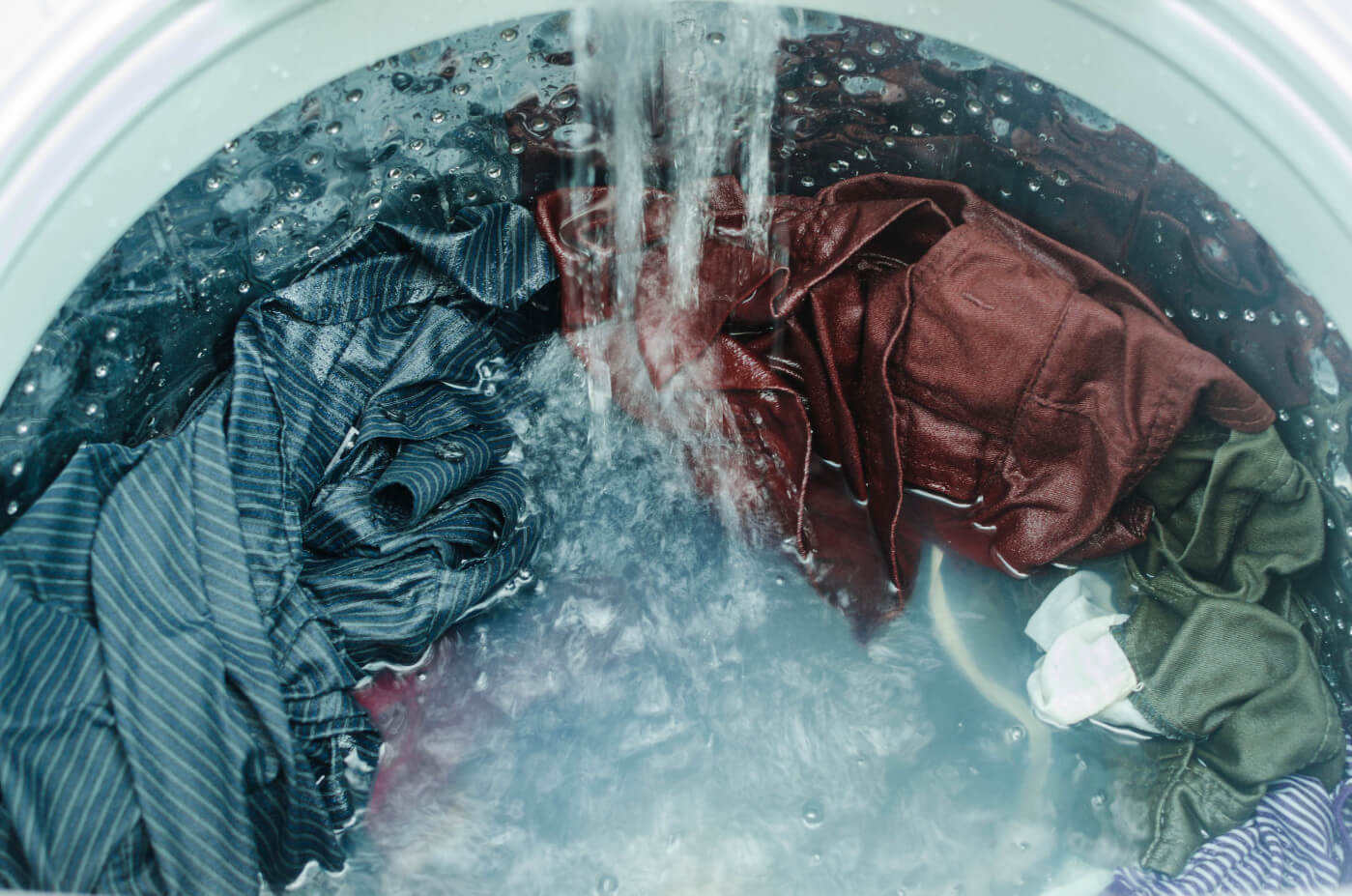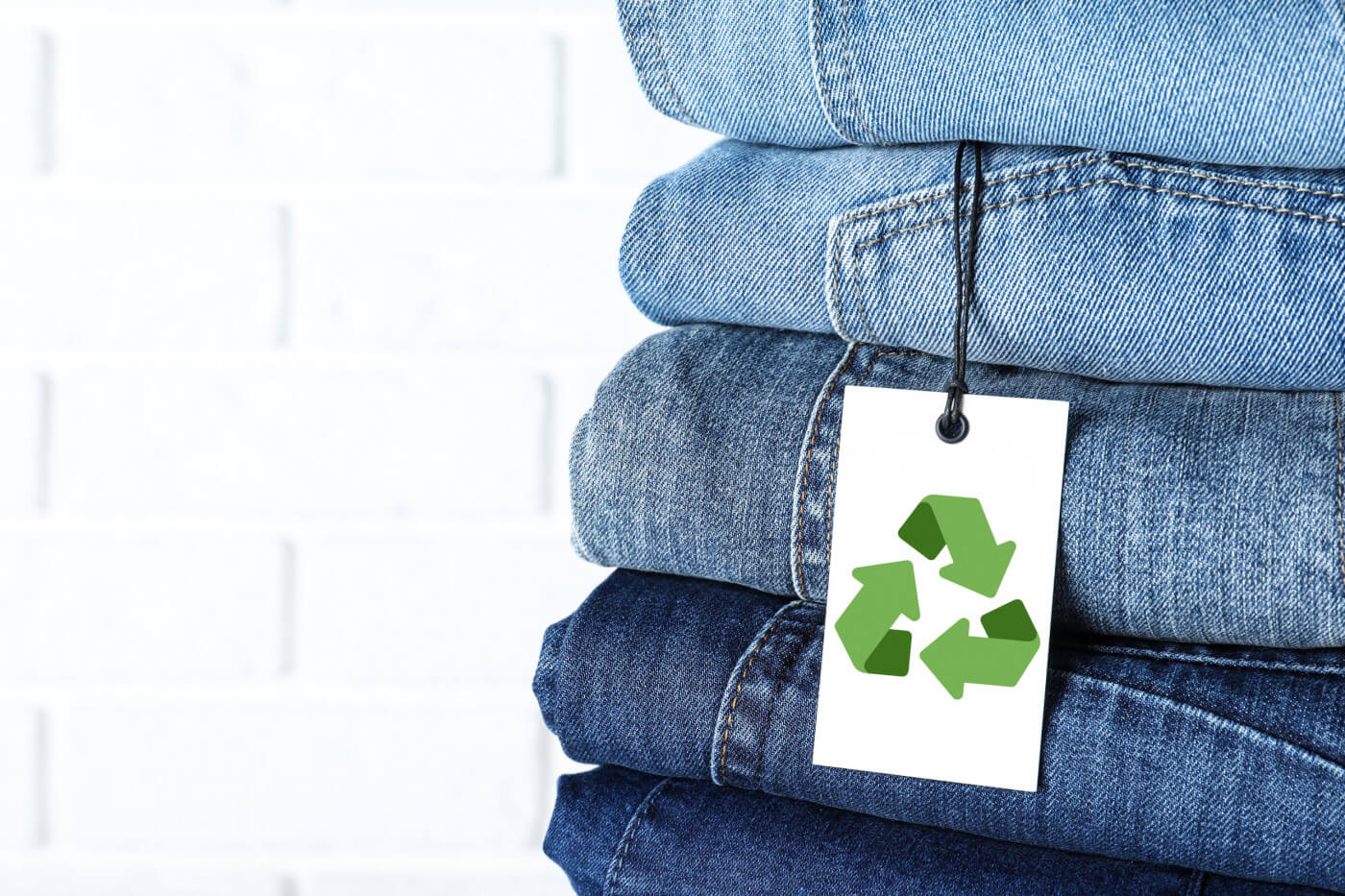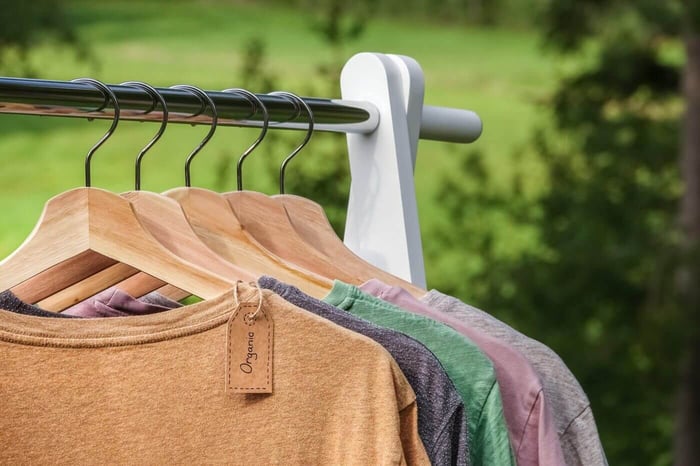 Clothes care is easier than you would think. You can keep them in good condition from the time you get them home by simply following a few simple guidelines.
Clothes care is easier than you would think. You can keep them in good condition from the time you get them home by simply following a few simple guidelines.
If you know how to take care of them properly, it’s easy! We created this guide so that you don’t have to worry about ruining your new favorite outfits. You’ll learn everything from what type of detergent is best for different fabrics, to how often you should launder different types. Understanding laundry symbols is also crucial for proper clothes care, as they guide washing, drying, ironing, and dry cleaning.
And if all else fails, we have a list of tips on how to get out stains- even the toughest ones, using the Nori Press! This blog post about clothes care will teach you all sorts of tricks that are quick and easy so that your clothes stay looking new longer than ever before. There are plenty of other helpful tips for clothes care too, but let’s start with the basics.
ARTICLE SECTIONS
Use discount code “SHOP10” at checkout to save 10% on The Nori Press!
Keeping Clothes In Good Condition
Wash new things before you wear them
Some feel that washing your new things before you wear them takes out a bit of the stiffness that may be part of the manufacturing process. This is a purely personal choice and oftentimes depends on what that new garment is.
Sometimes when your clothes are brand new, they’re often still stiff from being starched and pressed at the factory. This makes it difficult to move around or even sit comfortably. Washing breaks down this starch to make the clothing softer and more breathable. If your brand-new clothes have a distinct chemical smell, this is because they’ve been coated in finishes that keep the fabric from being damaged during transport and storage. This can be a good reason to wash them before wearing but please be certain that you want to keep your new item before you wash it since many stores will not take things back that have been laundered.
Wash dark colors separately from light colors
 If you wear both dark and light colors, then you should definitely wash them separately- especially if they’re made from different fabrics. This is because dark dyes can bleed more than light dyes do, which can end up ruining a lighter shade of clothing. Even if the darker color isn’t noticeable on the lighter piece of clothing after being washed, it’s still best to separate them so you don’t have to do extra washing in the future.
If you wear both dark and light colors, then you should definitely wash them separately- especially if they’re made from different fabrics. This is because dark dyes can bleed more than light dyes do, which can end up ruining a lighter shade of clothing. Even if the darker color isn’t noticeable on the lighter piece of clothing after being washed, it’s still best to separate them so you don’t have to do extra washing in the future.
Wash clothes using a mesh laundry bag
This helps protect your more delicate clothes from snags and tears that can happen in the washer. Mesh laundry bags are inexpensive and easy to use, especially when it comes time to throw your laundry into the machine. Clothes that are already somewhat worn over time can end up looking even worse after the washer.
Check your clothing labels before choosing a washing method
Different types of fabrics can require using different water temperatures or spin speeds. The label on each piece of clothing will tell you exactly what you need to know regarding washing and drying. Understanding clothes washing symbols and drying symbols on these labels is crucial for proper garment care.
Hang up your clothes to dry
Some types of clothing will last longer and look better if you can avoid the dryer. Air drying your clothes often prevents shrinking and can help maintain the shape of certain fabrics. The heat of the dryer can sometimes deplete the elasticity of garments such as your workout clothes. To air dry you can use a drying rack or drying your clothes outside is another good choice if you have the outdoor space. The dry flat symbol indicates that certain garments should be laid flat on a drying rack or soft towel to air dry.
Use a fabric softener or sheet to ward off static cling
Softener sheets and fabric softeners can make it easier to remove lint and pet hair from the clothing that you’re wearing. It also reduces static cling. There are several options when it comes to dryer sheets and fabric softener. For those of you with allergies or even if you just want a fragrance-free option, you can find fragrance-free sheets and softeners.
Don’t overdry your clothes
Leaving your clothes dryer on until you can get to it is probably a habit you don’t want to get into or one that you should break. Overdrying your clothes can be hard on them and your power bill! Some dryers have an option that will alert you to when the drying cycle has ended and some will even intermittently power off and on until you’re ready to take your clothes out. Try to also use the lowest heat setting for your clothing to help keep them lasting longer. The tumble dry symbol on your clothing labels indicates whether an item can be put in the dryer and provides guidance on heat levels for tumble drying.
Remove all dryer lint
This is an easy way to avoid damage to your clothing items that can lead to tears or snagging during wear. You’ll also reduce static cling if you make this part of your laundering process. Dryer sheets help collect the lint as it comes out of your dryer, but it’s also easy to remove any that ends up on clothing items.
Remove stains as soon as possible
Don’t let a little dirt or food stain ruin your favorite outfit. Whenever possible, try to get a stain out as soon as it happens. If you happen to be a “repeat offender”, there are even stain remover pens that you can get at your local grocery store. Maybe a little sparkling water or soda water will do the trick until you can get it home. If you wait too long, these types of stains can become set in and more difficult to get out. When you find a stain, pre-treat it with a laundry booster so the stain is less likely to become a permanent fixture on your clothing items. If you can’t remove a stain right away, soak the garment in cool water and use a brush to gently scrub the affected area before laundering as usual.
How Often Should You Wash Each Type of Clothing?
 This is another one of those things that are completely personal but let’s get into it! It’s going to depend on what it is and what you’re doing in it. Here are clothes care tips for each clothing type:
This is another one of those things that are completely personal but let’s get into it! It’s going to depend on what it is and what you’re doing in it. Here are clothes care tips for each clothing type:
Jeans
Some can be heavy and thick, so the fabric may not breathe as much as other types of clothing. You should definitely wash them after wearing them a few times because jeans tend to trap body odor more than lighter clothes. The absence of lines underneath the washtub symbol indicates a normal wash setting, which is suitable for jeans.
Sweatpants
These should also be washed after a few wearings because they’re similar to jeans in terms of being a heavier fabric. It also depends on if you’ve been working out in them versus just lounging around the home. Using the permanent press cycle can help reduce wrinkles and maintain the fabric quality of sweatpants.
Sweatshirts
Since sweatshirts are made of different materials, they can be worn more than once between washes depending on the type of activity and fabric they’re made of.
Outerwear
This includes jackets, coats, and other outer garments that you typically wear to keep yourself warm. If you’re just wearing them to run in and out. of abuilding then they’re not getting much wear and can go a long while between cleaning. If you’re in a cold climate and commute long distances then as a rule they’ll need to be tended to a little more often. Nothing worse than a crowded subway, bus or room with a lot of outerwear needing a cleaning.
Pants
These should also be washed after wearing them a few times depending on how long and where you work them. Like most of your clothing, it’s always a good idea to rotate.
Bras
Since these are worn in contact with your skin, it’s a good idea to wash either daily or after a few wearings. Once again totally dependent on what you do during the day or night.
Towels
These should also be washed based on your personal preference or at least after a few uses. Depending on the climate you’re in, towels can quickly develop a musty odor. It’s best to wash towels separately from other items. It’s important to remember that too much fabric softener will cut down on the absorption of towels so either uses a dryer sheet or not much fabric softener.
Socks
Wash socks after each wear. For athletic socks, it’s especially important to remove them as soon as possible after exercise to ward off athlete’s foot.
Bed Sheets
Sheets should be washed at least once per week to reduce the number of bacteria and contaminants that accumulate on them. You should also wash your pillowcase after wearing it several times because pillows can accumulate dust and other particles as you sleep.
Activewear
Even if you’re only wearing an item once, it’s good to wash it afterward so that any sweat or grime doesn’t build up on your clothes. Washing clothes after every use can help to keep them in good condition and protect them from smells and impurities that could cause damage.
Sneakers
Please check with the manufacturer of your sneakers to confirm that they can go in the washer. Many sport sneakers cannot be machine washed. It’s an easier bet that kids sneakers can go in the washer. Those sneakers that can be washed can often times go into the dryer provided you don’t mind the clanging noise as they tumble.
T-Shirts and Tank Tops
Washing your t-shirts and tanks will once again depend on personal preference and what you’ve been doing in them during the day. This will vary from a single wearing to two or three.
Workout Clothes
Wash your workout clothes after every exercise session. There are detergents specifically made for workout clothes and some of the regular detergents include odor busters to keep them fresh. Fabric sheets and fabric softeners are usually not a good addition for these fabrics and they tend to last longer if kept out of the dryer or if necessary at a very low temperature so that they maintain their elasticity.
Cotton Clothing
Wash your cotton when you feel that the freshness has left. All types of clothing are made of cotton which typically breathes well and more easily maintains its crisp quality. Treat stains as soon as you can because cotton does tend to soak up a stain easily. If possible wash cotton in cool or warm water. Hot water can definitely shrink cotton that has not been pre-shrunk by the manufacturer. Cotton typically does well with either a dryer sheet or fabric softener.
Wool Clothing
Checking the label of your wool pieces is key. Once you’ve done that you’ll know if you can wash them or not. Wool can be tricky to wash so try using one of the great wool and cashmere sprays on the market to prolong the freshness of your garments. Try turning your woolens or cashmere inside out after wearing to air them out. There are also detergents made specifically for wool and cashmere if you go down that road. You will want to test a small less noticeable part of the garment before washing the whole thing. It’s a good idea to ask the salesperson about laundering your new wool sweater. If they don’t know they may be able to ask customer support for you.
Silk
Most silk pieces should only be hand washed but there are many today that can absolutely go in the washer on the delicate cycle. You might want to put them in a laundry bag. Once again, check the label beforehand. As with wool and cashmere, there are products on the market made specifically for silk. Fabric fresheners, detergents will keep those silk pieces like new for a long time.
Knowing how to properly launder clothing can enhance its longevity, help with sustainability and also save you money.
Use discount code “SHOP10” at checkout to save 10% on The Nori Press!
Garment Clothes Care Tips
 Try the Nori Press and Fabric Facial
Try the Nori Press and Fabric Facial
The Nori Press is a great new product recommended for all clothes that need pressing or just freshening up. Its unique compact design takes on the old chore of ironing in a fun new way and extends the life of your clothes.
Try to air out your clothes after wearing them
Getting air to all parts of a garment is an easy way to keep them fresh and clean. Whenever possible, leave garments open to the elements or hang them up in a well-ventilated area so that air can circulate and any moisture evaporates before you wear them again. If you do this, they should stay clean longer and you'll need to wash them less often.
Take care of stains immediately
It's important to treat all types of fabrics before putting them in the washer so that you don't have to re-wash them. Try using one of the many stain fighters on the market. Sometimes you may have to let the stain fighter sit on the stain for a while before washing. This is better than scrubbing the stain and damaging the fabric.
What 'Not to Do' When Washing Clothes for Clothes Care
 Never wash wool with cotton
Never wash wool with cotton
You should always avoid washing items made of cotton and other natural fibers together because the fabric will shrink. This is especially important to keep in mind if you’re wearing an item made from both materials because the fabric can shrink unevenly! A good time to follow the label instructions! Understanding washing symbols on clothing care labels is crucial to prevent fabric damage and ensure proper washing.
Wash any clothing that’s labeled “hand wash” by itself
If your clothing is labeled as hand wash only and you decide to put it in the washer always put it in a laundry bag before you wash it and opt for the delicate cycle.
Don’t use hot water on wool
Wool items should never be washed in warm or hot water because this will shrink them. Always wash wool clothing in a cold or lukewarm setting to prevent the fibers from being damaged.
Don’t put knits and elastic materials in the dryer
If you’re washing a knit garment, always air dry because tumble drying can damage the fabric. Elastic materials should also be air-dried because they can be stretched out from being dried too quickly in a machine.
Don’t wash new clothes before dry cleaning them
If you’re purchasing a piece of clothing that needs to be dry cleaned, don’t wash it before taking it to the cleaners because that can cause damage as well. Make sure to follow any instructions on the tag before using this method of care.
Don’t over-dry clothing
Over-drying natural materials like cotton can cause the fabric to shrink.
Clothes Care Tips for Storing Your Clothes Away
 Place all clothes in a laundry bag before storing
Place all clothes in a laundry bag before storing
If you're putting an item made from different materials into storage, it's always best to put them in a large mesh bag or use a plastic bin with holes so that they don't get damaged. Always check the label on your clothing to ensure there aren't any special instructions for storage.
Fold or hang your clothes according to their material
When you place items made from different fabrics into storage, it's important that you fold them accordingly. For example, knit garments should always be folded in half and hung up because folding them could cause damage to the fibers. Always check the care label for special instructions if you're unsure about how to store a particular item.
Keep sharp objects away from clothing
Clothes can easily be cut or ripped by sharp items like paper clips, pens, and safety pins if they're put in storage with them. To avoid this from happening, always place these types of sharp objects in a plastic container before placing them in your storage unit.
Use hangers with distinct shapes for certain types of clothing
If you're placing hangers in your closet, make sure that they have a unique shape or color so that you don't accidentally use them on something other than the type of garment it's meant for! This is especially important to keep in mind if you're using hangers with clips to hang dresses and suits because the clip could snag another item.
Keep shoes in a plastic bag
If you're storing your shoes away for the season, make sure to place them in a plastic bag first. This will prevent any dirt from getting on other clothing items or materials! It can also help to put cedar balls in your shoes while they're in the bag. This will keep them smelling fresh throughout the year.
If you have space, store all clothing together
When it comes to storage, especially if you have a lot of clothes that are similar in size and material, it's best to group items together. This will make it easier to find what you're looking for and ensure that your clothes don't get damaged from being stored in the wrong places with other items!
Use large storage containers
If you have a lot of clothing, especially things like coats and boots, it's best to use clear or very large plastic containers for these items. This will keep them from getting damaged and make it much easier to find the item you're looking for!
Hang coats and jackets
When storing outerwear, it's best to hang all items because it will keep them from getting wrinkled or crushed. This also allows you to see all of your options at once so that you pick the coat you want more easily!
Put away belts and scarves
Belts and scarves can easily get tangled or wrinkled if they're just balled up and shoved into a drawer. To avoid this, roll them up before putting them in storage so that you'll be able to spot them at a glance when you're looking for an item to wear!
Store boots on their side
Boots can get damaged if they're stored upright because the weight of one boot crushing the other can cause a lot of wear and tear over time. Instead, lay them down flat in a boot storage unit so that they don't get squished or misshapen! Stuff your tall. boots and lay them on their side. They'll also be easier to spot at a glance once you're looking for the pair that you want.
The best place to store clothes is in your closet
A great way to keep clothing in good condition over time is to store them close by so that you can wear them frequently throughout the year! If this isn't possible, storing your clothes in boxes or garment bags in your closest is the next best thing.
Keep like items together
To make it easier to pull out certain clothes, places like items in their own individual boxes or storage containers. For instance, if you're storing several blouses together, put each one in its own plastic container or bag so that they don't get damaged while they're in storage.
Label all containers
When you're storing clothing away at the end of the season, it's important to label each individual container so that you know exactly what type of clothes are inside. This will make it easier to find certain items when you need them and ensure that they don't get damaged by being stored in the wrong places with other items!
Keep items with leather separate
When storing any clothing that has pleather or leather parts, it's best to keep these items away from other materials because certain fabrics can actually eat through the faux leather! This can damage the seams and cause the faux leather to crack over time, so be sure that these items are separate from any other items.
Keep sweaters out of sunlight
When storing sweaters for the season, it's best to keep them away from any direct sunlight. If they're left in a place that gets a lot of sunlight, the colors can fade and the material can become damaged by the UV rays. This is especially important for dark-colored clothing!
How to Remove Stains and Odors from Fabric
-
 To remove oil-based stains, you need an oil-based stain remover. Spray or rub the mixture onto your clothes and allow it to sit for a few minutes before washing them as usual. Always read the stain remover instructions to make certain that it won't harm the fabric.
To remove oil-based stains, you need an oil-based stain remover. Spray or rub the mixture onto your clothes and allow it to sit for a few minutes before washing them as usual. Always read the stain remover instructions to make certain that it won't harm the fabric. -
To remove odors from lightweight clothing mix 1 teaspoon of liquid hand dishwashing detergent and 8 ounces of lukewarm water. Then, soak a new or clean cloth in the mixture and wipe down your clothes. This will remove odors from lightweight clothing without damaging them!
-
For stubborn odors, mix 1/4 cup of rubbing alcohol with one cup of water. Soak a new or clean cloth in the solution and then wring it out until damp. Gently rub the solution onto your clothes to remove odors. For stubborn odors, try applying the solution directly to your clothes. Always check the garment label.
-
For tough stains, rubbing alcohol is usually the best way to remove odors and vinegar works great on mildew smells!
-
To remove odors from all types of clothing, including workout gear, mix 1/4 cup of baking soda with 4 tablespoons of liquid hand dishwashing detergent. Then, add water until the solution measures one cup. Stir it together well and use a new or clean sponge to rub it onto your clothes. Allow the solution to sit for up to 30 minutes before rinsing and washing as usual.
-
To remove stains from your clothes, try a paste made from 1 tablespoon of cornmeal and enough water to form a paste. Apply it to the stain and allow it to sit for at least 15 minutes before washing as usual.
-
To remove both stains and odors from all types of clothing, mix together 3 tablespoons each of baking soda, salt, and white vinegar. Then, add enough water to make a paste. Apply the mixture to your clothes and allow it to sit for about 30 minutes before rinsing and washing as usual.
-
For long-lasting freshness, mix together 1 tablespoon of salt with 1 cup of warm water. Dip a clean cloth or sponge into the solution and wring it until damp. Use it to scrub your clothes, then rinse and dry them as usual.
Choosing the Right Laundry Detergent
 Know the best way to wash your clothes because doing it incorrectly can damage them and wear them out much faster than they would if you just knew a few tricks. While we don't always feel that a specific laundry detergent is needed for each type of fabric, sometimes even using the right technique isn't enough - you may need to use the right product for each garment, too. So, here's how to know what the best laundry soap for clothes care:
Know the best way to wash your clothes because doing it incorrectly can damage them and wear them out much faster than they would if you just knew a few tricks. While we don't always feel that a specific laundry detergent is needed for each type of fabric, sometimes even using the right technique isn't enough - you may need to use the right product for each garment, too. So, here's how to know what the best laundry soap for clothes care:
-
Wool/Cashmere- Woolite Delicates is gentle enough to use on wool and cashmere, but tough enough to fight stains. It has a 3x cleaning formula that gets clothes cleaner than other detergents made for silk or cashmere. And natural enzymes work to get out odors without any scent added.
-
Silk- Persil Silk is specially made for laundry of all different natural fabrics, including silk. It's super concentrated so one bottle will last through 30 washes. And it works in both high efficiency and standard machines! It can even be used with cold water if you want to- so you don't have to worry about your silk getting ruined by hot water.
-
Rayon Lace- Tide PODS 2 in 1 offers great options for delicate garments like lace and rayon. It's tough enough to remove stains while at the same time, it won't compromise the fabric material that the garment is made of. It's the only 2-in-1 type detergent that isn't combined with bleach, so you can be sure your clothes will stay color-safe through the wash. Don't forget to check your clothing labels.
-
Acrylic/Nylon- All Free Clear Laundry Detergent is specially formulated for loads containing synthetic fabrics like nylon and acrylic. And this detergent is perfect for any water temperature, so you don't have to run an extra load with hot water if you don't want to.
-
Polyester-Tide PODS offers versatility for polyester clothes! The solid form of this detergent makes it the perfect option to use in high-efficiency washing machines. Plus, they're effective on both stains and odors, so you know you're getting the best clean possible every time!
-
Spandex- Downy Unstopables In-Wash Scent Booster is perfect for adding extra scent to your workout clothes. And as a bonus, it also helps your clothes retain their original shape and color by protecting them from fading. There are various scents that you can choose from as well, so you can have fresh-smelling laundry that smells just as nice as it looks.
-
Cotton- Tide Liquid offers great options for cotton articles of clothing. It's a versatile product and can even be used in high-efficiency washing machines! And it's tough on stains, which is great for saving time on wash day.
-
Linen/Bedding- Biz Liquid Laundry Detergent offers the benefits of liquid detergents without compromising on scent. It has a matte finish formula that won't leave clothes or linens feeling greasy, so it's perfect for bed sheets, pillow cases, blankets, and more.
-
Polyester Blend- Gain Liquid Laundry Detergent can be used on all different types of fabric blends to get them clean while maintaining their color vibrancy. It has the power to target tough stains without compromising on scent. And it's great at fighting static cling, which saves your clothes from becoming a mess of fuzzballs or sticking together.
-
Rayon- Woolite Everyday is gentle enough to be used on all different types of fabric, including Rayon! It will leave your clothes feeling fresh and clean with no residue left behind. Plus its formula is tough enough to tackle stains, while also being gentle on fabrics.
-
Nylon- Purex Complete 3 in 1 offers a 3-in-1 formula that lets you do your laundry all at once! It will remove stains from fabrics while leaving them feeling fresh and looking vibrant. Plus, it can be used for heavy loads to get out even the toughest stains. And it's great for high-efficiency washing machines, so you don't have to worry about special settings or water temperatures!
-
Bamboo/Modal- Arm & Hammer Essentials Natural Laundry Detergent is made to clean and refresh all different types of natural fabrics, like bamboo and modal. It has a gentle formula that's perfect for high-efficiency washing machines, and it can also be used in standard machines too! Plus, with its 24/7 freshness technology, you will always have a fresh wardrobe.
-
Cotton-Arm & Hammer Plus Oxi-Clean can be used on all different types of fabrics from cotton to wool. It helps reduce static cling and can be used in high-efficiency washing machines. And it's powerful enough to get out hard stains while still being gentle on fabrics, so you won't have to worry about colors fading or fabric damage!
Sustainability and Taking Care Of Your Wardrobe
 We all know the fashion industry carries a hefty environmental footprint. From systemic and supply issues to animal welfare concerns, much work needs to be done to clean up our clothes production. As individuals and consumers of clothing, we are inherently woven into, and cannot discount, our role in clothes care and fashion's footprint on the planet.
We all know the fashion industry carries a hefty environmental footprint. From systemic and supply issues to animal welfare concerns, much work needs to be done to clean up our clothes production. As individuals and consumers of clothing, we are inherently woven into, and cannot discount, our role in clothes care and fashion's footprint on the planet.
Fortunately, there are many ways that each one of us can make an impact by taking simple steps like buying less or choosing more sustainable materials; but also making sure what you buy has been produced ethically and sustainably. Here are just a few things to consider when it comes to caring for your wardrobe.
1) Buy Less
The first step towards reducing your carbon footprint is simply not purchasing as much new stuff. If you already have enough clothes, accessories, shoes, etc., then this may seem impossible. But if you really think about how often you wear something, you'll realize that most items will last at least three years before they need replacing. So instead of spending $100+ on a pair of jeans, invest in quality pieces that won't go out-of-style so quickly.
2) Choose More Sustainable Materials
If you're looking to reduce your overall consumption, start with where you shop. Shop for clothing made of recycled cotton, linen, recycled nylon or hemp. Depending on their source other good choices. are sheep w wool, merino wool, alpaca and cashmere.
3) Shop Ethical Fashion Brands
There are plenty of ethical brands out there that offer high-quality apparel without compromising ethics
Some examples include Patagonia, Gildan Activewear, and Karmaloop. When shopping online, look for companies that support Fair Trade Certified™ programs, which ensure workers receive safe working conditions, decent wages, health benefits, and freedom of association.
4) Use Recycled Textiles
Recycling textiles helps prevent waste from going into landfills and saves valuable landfill space. It also reduces pollution caused by manufacturing processes and eliminates the need for virgin raw material extraction. There are several different types of recycling methods available including reusing old garments, and repurposing used fabric.
5) Wash Like A Pro
Washing machines consume massive quantities of electricity and water. To save money and conserve resources, wash only full loads. Also, avoid using hot water unless absolutely necessary. Hot water uses twice as much energy as cold water. And finally, remember to hang dry your clothes whenever possible. Dryers use huge amounts of power.
6) Repair & Replace Old Items
Repairing an item yourself allows you to keep it longer and prevents unnecessary waste. Plus, when you repair something, you get to learn more about its history and appreciate what makes it unique. There a re great new sites such as Poshmark and Threadup that offer great options on gently used clothing for a fraction of the original price.
3) Store Clothes Properly
Store your clothes properly so they don't fade, wrinkle, or lose shape. Place sweaters and jackets away from direct sunlight since heat causes color fading.
4) Donate Unwanted Garments
Donating unwanted clothing not only helps others but also cuts down on the amount of trash ending up in landfills. If you don't have room in your closet, consider donating to local charities or shelters instead. You could even turn your donations into cash through resale sites like Poshmark.com. Organizations like Dress for Success can make great use of your gently used items.
5) Get Organized
Keep track of of your clothing so you don't double purchase. Sometimes you'll see an outfit online or in a store that looks great! Think a bit and you may be able to pretty closely duuplicate it in your own closet.
6) Buy Less Stuff
The average American consumer buys around 50 new pieces of clothing each year. That's nearly one outfit per week! You may be surprised at how quickly you fill up your closet if you buy too many things. Not to mention, most of those purchases end up sitting unused in storage or taking up precious real estate in your home.
8) Swap With Friends
Swapping clothes with friends lets everyone benefit from each other's wardrobe. If someone has extra pieces lying around, consider asking if she'd be willing to swap. Many stores are even taking back your old jeans and offering a discount for new jeans!
8) Buy Used
Buying preowned items will likely cost less than purchasing brand-name merchandise. Take a look at Poshmark or Threadup. Try some of the new rental programs that stores are offering
Care For Your Clothes Today
Taking care of your clothes is simpler than you might think. By following a few straightforward guidelines on clothes care, you can keep your garments looking fresh and lasting longer. For an added touch of convenience, consider using the Nori Press. This innovative product offers an easy and efficient way to press and freshen your clothes, extending their lifespan. Shop the Nori Press now!
More "How To" Clothes Care Articles
Use discount code "SHOP10" at checkout to save 10% on The Nori Press!




![How to Get Highlighter Out of Clothes [20 DIY Tips] – Nori Press](https://dropinblog.net/cdn-cgi/image/fit=scale-down,width=700/34243516/files/featured/Highlighting_report_risk_of_stain_on_clothes.jpeg)



